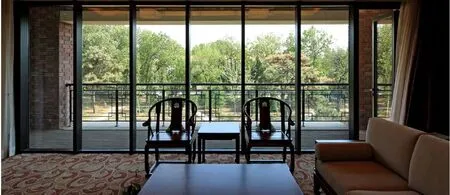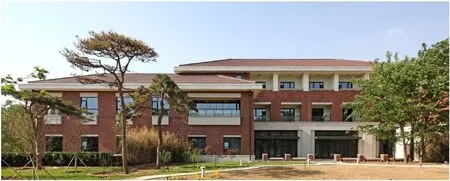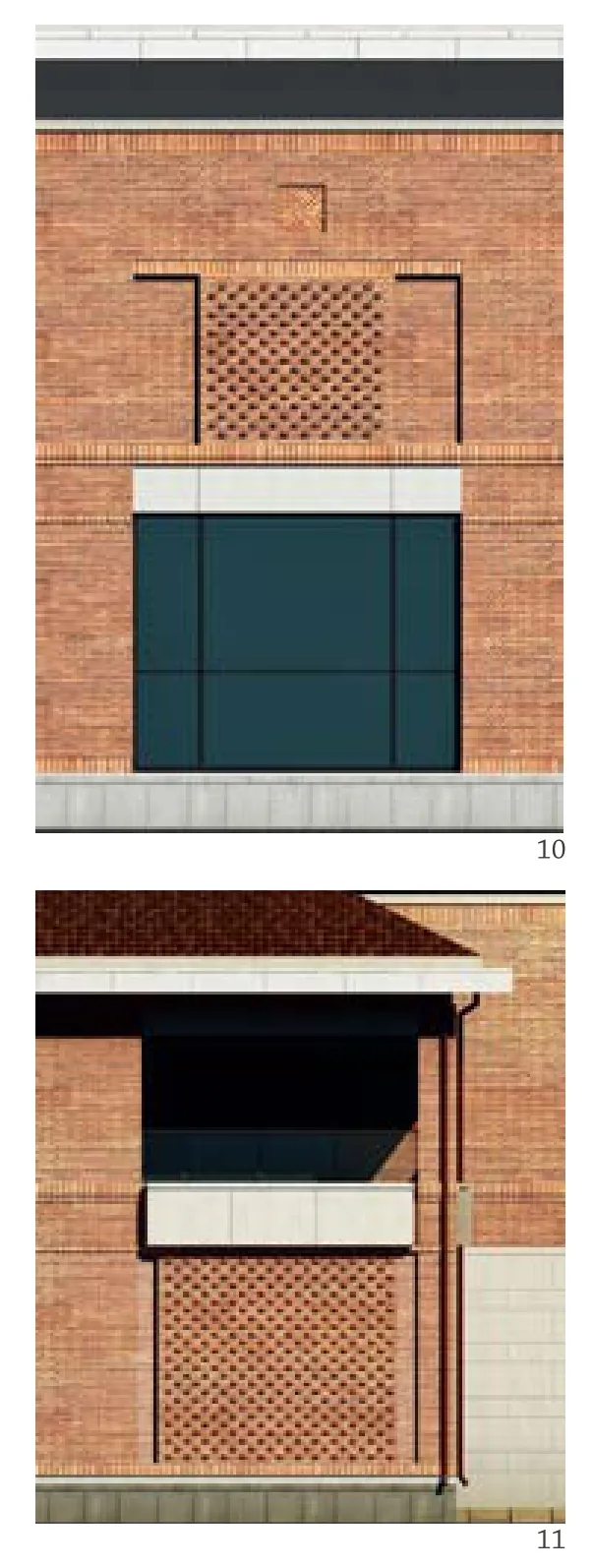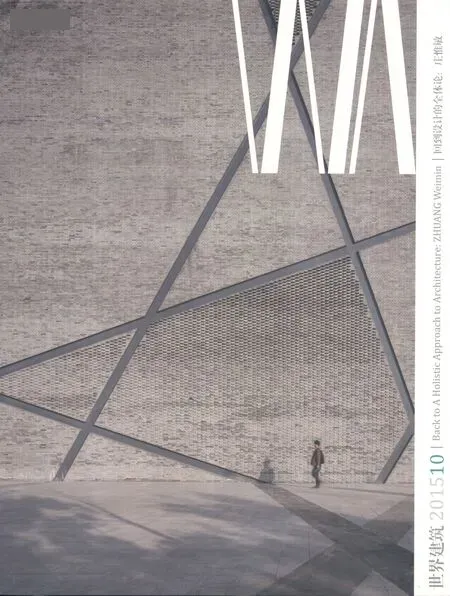钓鱼台国宾馆3号楼和网球馆,北京,中国
钓鱼台国宾馆3号楼和网球馆,北京,中国
Tennis Hall of Villa 3 in Diaoyutai State Guest House, Beijing, China, 2011
钓鱼台国宾馆坐落于北京三里河路西侧的古钓鱼台风景区,始建于1958年,是国家领导人外事接待的重要场所。国宾馆全园占地42hm2(湖水面积约7hm2),初期建成15栋别墅式接待楼,总建筑面积16.5万m2。原3号楼即为其中之一,后又就近增建了网球馆。随着国宾馆使用需求的不断发展,原3号楼和网球馆功能、规模及服务标准也迫切需要改善。
原址重建的新3号楼和网球馆建筑地上3层,地下一层,3号楼主要功能包含首层独立使用的大会客厅,大、中、小餐厅各一处以及厨房、接待大堂和部分客房;二、三层主要为包含团长房等在内的共计26自然间的客房。网球馆包含两块室内标准场地及更衣间、休息区等必要的配套设施。国宾馆园区整体规划延续了中式造园理念,湖岛相间;建筑布局主次分明, 3号楼用地位于园区主轴线东侧,面西而立,处于从属地位。新建筑的设计,充分尊重园区整体规划的空间序列,定位“背景建筑”,服从全局,烘托环境主题。
为契合整体规划思想,维护园区已有的尺度和肌理,新建筑采用化整为零的办法减小建筑的体量感,围合内院、体块咬合搭接形成退台,避免了大体量的出现,客房楼单走廊模式布置满足了其良好的采光和通风需求。
新建筑的造型采用红砖坡屋顶的形式,呼应原3号楼具有民族特点的设计。在歇山顶山墙设置建筑主入口,白色门廊、砖饰面线脚等元素的应用,延续了建筑环境的记忆,对国宾馆建筑文化的传承起到重要的积极作用。建筑局部三层部分向后退让,避免了由于规模增加带来的扩张感,叠落的平缓四坡屋顶使建筑体量层次更加丰富。网球馆主体造型为四坡盝顶,檐下内收,从视觉上降低了高度。
新建筑外墙采用了“夹心”砖幕墙搭配石材干挂的作法,立面效果立体、细腻。建筑窗上、下及层间部位逐层出挑的竖砖腰线,调整了立面竖向比例;主入口部位及墙面盲窗部位采用丁头砖装饰,避免了立面过于呆板压抑,光影生动。局部铜质装饰烘托出建筑整体的文化气质。
古树植物是建筑环境历史的重要组成,设计和建造中保留了原建筑入口处标志性的古松,留下了记忆。
建筑室内注重表现民族特色的建筑文化,设计定位 “高大敞亮、庄重典雅”,以考究的陈设形成大气的文化品位。接待大厅的设计简约现代,通过光影变化烘托空间意境。内院作为大厅的空间延续,很好地增加了对景的层次感。网球馆室内简洁、动感,局部的装饰纹样,增加了文化气氛,避免了体育活动场地千篇一律的单调感。□

2 主入口/Main entrance
项目信息/Credits and Data
项目负责人/Principal in Charge: 庄惟敏/ZHUANG Weimin
设计团队/Design Team: 庄惟敏,任飞,蔡俊,杜爽等/ ZHUANG Weimin, REN Fei, CAI Jun, DU Shuang, et al.
建筑基地面积/Building Area: 4379m2
总建筑面积/Total Floor Area: 12,129m2
建筑高度/Height: 17.7m
设计时间/Design Period: 2009.3-2009.8
竣工时间/Completion: 2011.5
摄影/Photos: 张广源/ZHUANG Guangyuan

3 鸟瞰效果图/Bird's eye view rendering

4 网球馆内景/Interior view of Tennis Hall
Diaoyutai State Guest House is located at the Diaoyutai scenic area, west of Sanlihe Road in Beijing. Originally built in 1958, this complex of houses continues to serve an important role in receiving official foreign guests. The site's area is 420,000 square meters, of which 70,000 square meters is water. Villa 3 is one of the earliest completed of the cluster of 15 houses, and the tennis hall was built as a later addition. As the usage demand increases, the old building needed to be upgraded and renovated.
the rehabilitated building features the following changes: the first floor has an meeting room, three restaurants of different configurations, a reception hall, and several guest rooms. the second and third floor has 26 guest rooms. The Tennis hall has two standard courts and accessories such as dressing room and a lounge. While the surrounding landscape inherits the traditional Chinese garden typology with water and island intertwining between other, Villa 3 is placed into a subordinate hierarchy on the east end of a main visual axis facing west. the new design pays respect to this planned sequence of space, and acts as a "background" building.
In order to cooperate with the overall plan and retain an appropriate scale and texture, the new building breaks down scale by providing an inner courtyard and setback terraces. A single row of side rooms provides good lighting and ventilation.
The Building adopts an original ethnic style, characterized by an untidy roof and red bricks. Its entrance is located at Xieshan gabled wall, and with its white porch and brick, it invokes the memory of the original design. A third floor setback breaks down the building's volume, while its hipped roof creates a rich, layered facade. the tennis hall's Lu-shaped roof is setback under the eave to make the building appear lower.
the building's facade uses a "sandwich-like"brick wall with dry-hanging stone panels. In order to create a vivid shadow effect, the lintel and sill bricks cantilever out, while false windows are detailed with header brick. Bronze detailing is also utilized to connote a traditional atmosphere.
The existing pine trees at the entrance have been preserved to retain the memory of the site.
the interior is also national style oriented. Its design is focused to bring brightness and elegance to the building, and the furnishings help to create a high-end atmosphere. The reception hall is simple, modern, and the landscape of the courtyard acts an extension of the hall itself. The tennis hall has a concise interior design, with decorative patterns emphasizing movement in order to avoid the conventional tedium of sports buildings.□

5 首层平面/Floor 0 plan

6 内庭院/Inner courtyard

7 二楼接待室/Reception room on the second floor

8 网球馆外景/Exterior view of Tennis Hall
评论
黄居正:作为一种传统的民间建筑材料,红砖所散发出的温暖、亲切的手工感,以及通过砌筑工艺形成的各种独特的肌理感,逐渐为现当代建筑师所青睐,使它不再局限于民间建造中的使用。阿尔瓦·阿尔托的塞纳特塞罗市政厅、夏季别墅,勒·柯布西耶的加乌尔别墅,都是实验性地使用红砖砌筑建造的现代建筑佳例。
钓鱼台国宾馆3号楼的外墙采用了“夹心”砖幕墙的技术,砖墙从支撑性的承重结构中解放出来,获得了一种表现的自由。主入口部分为了强调空间的竖向性,并调整立面比例关系,玻璃门窗的两边采用丁头砖的砌筑方式,所形成的凹凸表面产生了丰富的光影效果。在大面积一丁一顺砌筑的砖幕墙上,浅浅地凸出了一条有两重层次、竖向砌筑的带状水平线,这条带状水平线从视觉上区分了上下两个楼层。窗的部位,上下都使用了白色石材干挂。在窗上部梁的位置,通常建筑师会把两端延伸至两边墙中,以暗示结构和力的传递逻辑,但在这里,“梁”却与窗边沿及下部的白色“阳台”等齐,清楚地告诉你,这根白色的“梁”是装饰。同样,在丁头砖砌筑的盲窗部位,边缘留出了一条窄窄的缝隙,似乎也在提醒你,外墙只是一片装饰墙。建造的真实性以一种反向的姿态呈现了出来。
平面上,两个不同功能的方形体量咬合在一起,客房部分采用合院式布局。由于建筑外部有十分幽美的景观,内院仅需承担通风和采光的需求,因此,地面基本采用硬地化处理,局部点缀竹、石和草坪。
Comments
HUANG Juzheng: Red bricks are utilized as a traditional building material in folk architecture for numerous reasons. Their hand-made texture gives a feeling of warmth and amiability, which is complemented by the special touch left by the bricklaying process. Brick's popularity as a building material for contemporary architects has now surpassed its primary usage in folk architecture. there are several excellent works of modern architecture that utilize brick, such as, Alvar Aalto's Säynätsalo Town Hall, his Muuratsalo Experimental House, as well as Le Corbusier's Maisons Jaoul.
Villa 3 of the Diaoyutai State Guest House utilizes a technique called "sandwich", which consists of a brick curtain wall that serves as its external wall. this allows the brick wall to be liberated from being merely a supporting structure, providing an opportunity to freely express a design. Visitors to Villa 3 are immediately met by the main entrance – which emphasizes the vertical nature of the building's exterior, while modifying its overall proportions. Header bricks flank two sides of the glass window. the peculiar characteristics of this style of bricklaying allow the elements of light and shadow to work their magic. there are also two layers of horizontally-laid structure facing upwards and slightly protruding from the brick curtain wall; this separates the building visually into two stories. Stone Cladding is applied above and below the building's windows. Generally, architects tend to extend the upper beam into either side of a wall, in order to give the image of the transmissibility of force and structure. In the case of this building, the upper beam aligns with the lower beam, and a white balcony is placed to show that the upper beam is merely decoration. In this way, the narrow gap between the header bricks and the false window implies that the external wall is also for decorative purposes only and serves no function. this goes against the conventions of conventional construction.
Looking at the plan, there are two square buildings, which despite having different functions, are linked with one another. The guest quarters are located within the courtyard house, and only require minimal ventilation and lighting as the landscape outside of the building is rather scenic. Within the courtyard itself, beautifying methods include bamboo, stone paving, and a glass lawn, all of which have been used sensibly and without excess.(English translation by Dandan WANG)

9 剖面/Section

10.11 丁头墙设计图/the renderings of the wall with header bricks

12 丁头砖墙/Wall with header bricks

13 立面细部/Façade detail

